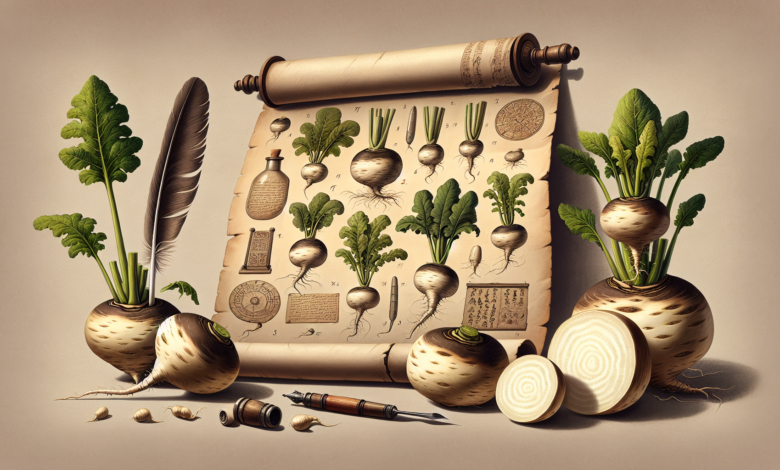Rooted in History: The Surprising Versatility and Health Benefits of Turnips

Rooted in History: The Surprising Versatility and Health Benefits of Turnips
Introduction
Ah, the turnip—a humble yet often overlooked vegetable, nestled among its more glamorous counterparts in the produce aisle. Available year-round, this curious root has been cultivated for centuries, finding its place not just in the hearts of avid gardeners but also on American dinner tables. It’s essential, now more than ever, to reimagine our connection to food, and the turnip—a nutritional powerhouse—deserves a spot in our health-conscious diets.
With health trends constantly evolving, the often-underappreciated turnip beckons us to pay closer attention. Let’s dig a little deeper into its fascinating history and explore why this versatile vegetable is worthy of your plate.
Description
Originating thousands of years ago, the turnip belongs to the cruciferous family, alongside broccoli and kale. This unassuming vegetable comes in various hues—white, purple, yellow, and even green—each boasting unique flavors ranging from subtly sweet to earthy. In America, turnips are typically harvested in the fall, their harvest coinciding with the cooling temperatures that signal their peak season—a delightful contradiction to their wintery demeanor.
But did you know that the turnip holds profound historical significance? Historically, it served as a staple food for ancient Greeks and Romans, often seen as a poverty food in certain cultures. Its robust nature made it an essential crop in time of famine, and it was even a part of the rations given to soldiers. Additionally, the turnip has cultural significance in numerous traditions, regarded as a symbol of resilience.
Health Benefits
Let’s veer into the realm of nutrition. Turnips are strikingly rich in vitamins C and K, folate, and manganese, all while being low in calories—making them an ideal companion on the journey toward health. Packed with antioxidants, these roots scavenge free radicals in the body, which promotes overall well-being and may intricately weave into the fabric of heart health and boosting immunity.
Recent studies have illuminated their potential role in weight management due to their high fiber content, which aids digestion and encourages a feeling of fullness. Additionally, experts from the Nutrition Society suggest that including turnips in your diet may support cardiovascular health. So, if you’re itching to nourish your body while tantalizing your taste buds, this root vegetable holds potential beyond the mere mundane.
How to Use
Turnips are culinary chameleons—slicing easily into salads, transforming into comforting mashed turnips, or roasting to marry sweet and savory notes. For a refreshing crunch, consider grating raw turnips into slaws or adding them to sandwiches. Cooking methods vary, too; you might steam them, sauté them, or even toss them onto the grill. Pair them with bright herbs like parsley or zesty lemon, or combine them with other seasonal veggies like carrots and parsnips for a medley of flavors.
Recipes
Let’s spark a culinary adventure with a simple yet delectable recipe: Roasted Turnips with Honey and Thyme.
Ingredients:
- 2 cups turnips, peeled and cubed
- 1 tablespoon olive oil
- 1 tablespoon honey
- 1 teaspoon fresh thyme (or ½ teaspoon dried)
- Salt and pepper to taste
Instructions:
- Preheat your oven to 400°F (200°C).
- In a mixing bowl, combine cubed turnips, olive oil, honey, thyme, salt, and pepper.
- Spread the mixture evenly on a baking sheet.
- Roast for 25-30 minutes or until golden brown and tender, stirring halfway through.
- Enjoy your delicious and nutritious dish!
For more intricate dishes, consider exploring turnip gratin or turnip stew recipes, promoting culinary creativity in your kitchen. And if time is of the essence, fear not—quick and easy recipes abound.
Tips for Buying & Storing
To select the freshest turnips, look for firm, smooth skin, free from blemishes. Ideally, they should feel heavy for their size, signaling moisture and vitality. As for storage, keep them in the crisper drawer of your refrigerator, where they thrive for up to two weeks. Tales abound of adventurous cooks who even freeze turnip cubes for soup and stews, effortlessly extending their culinary journey.
Precautions & Considerations
While they are generally safe for consumption, some individuals may experience mild digestive discomfort due to the high fiber content. Additionally, those sensitive to cruciferous vegetables may want to consume them in moderation. Insights reveal that, like many other vegetables, it’s always prudent to wash them thoroughly before cooking or eating raw.
Conclusion
In conclusion, the turnip—a vegetable steeped in history—offers a myriad of health benefits, versatility, and culinary opportunities just waiting to be explored. So why not challenge the status quo? This season, invite turnips into your meals, and watch as they transform not only your dishes but your health. Add this remarkable vegetable to your next grocery list and start reaping the health benefits! It’s time to dig in!




